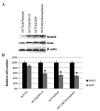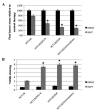Colorectal cancer stem cell and chemoresistant colorectal cancer cell phenotypes and increased sensitivity to Notch pathway inhibitor
- PMID: 25936357
- PMCID: PMC4464415
- DOI: 10.3892/mmr.2015.3694
Colorectal cancer stem cell and chemoresistant colorectal cancer cell phenotypes and increased sensitivity to Notch pathway inhibitor
Abstract
Colorectal cancer stem cells (Co-CSCs) are a small subpopulation of tumor cells which have been proposed to be tumor-initiating cells in colorectal cancer (CRC) and to be implicated in resistance to standard chemotherapy. Chemoresistance is a common problem in the clinic. However, the interrelation between Co-CSCs and chemoresistant cells has yet to be elucidated. The present study investigated the Co-CSC phenotype in colonospheres and chemoresistant CRC cell lines and aimed to identify targets for therapy. Colonospheres and chemoresistant CRC cells were found to be enriched with the CSC markers CD133 and CD44, and exhibited similar phenotypes. Furthermore, it was found that Notch signaling may simultaneously regulate Co-CSCs and chemoresistant cells and may represent a novel strategy for targeting this pathway in CRC.
Figures





References
MeSH terms
Substances
LinkOut - more resources
Full Text Sources
Other Literature Sources
Medical
Research Materials
Miscellaneous

